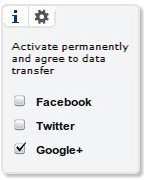More data protection in social media
We incorporate the Facebook, Google+ and Twitter 'Like Buttons' on our pages. These pages transmit data to the operators of the respective networks as soon as the pages are loaded. This means that the operators are able to create entire profiles of the user's Internet access. In order to stop this happening, we use the two-stage solution developed by www.heise.de. In this solution data is only transmitted with the user's consent.

We embed buttons in our pages that are not activated and therefore do not establish a direct contact to the Facebook servers or the servers maintained by other network operators. Users grant their consent to communication with the network by clicking on the button. The corresponding connection is not established until the buttons are active. Users can then send their likes by clicking on the button a second time. If the user is already logged in to the corresponding network, a popup window will appear in Twitter in which the user can process text for a tweet. This takes place on Facebook and Google+ without a separate window.
So clicking the button for the first time means that users grant their consent to the transmission of data to the respective provider of the social network. But this only applies to this one page and for the respective service they have selected. The button will appear deactivated again if the users accesses other Neudorff pages. But there is an option to permanently activate the button.

To do this you check the relevant box after clicking on the cogwheel (settings) symbol; users will then have precisely the same settings as on many other websites: The selected button is always directly active. Users can change this setting again by clicking on the cogwheel symbol.



